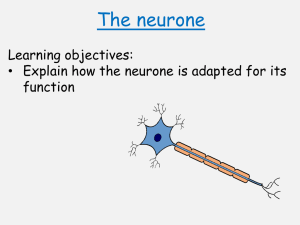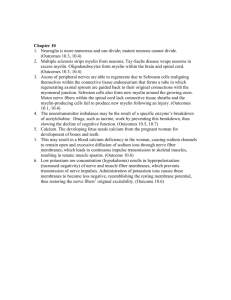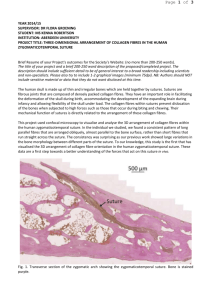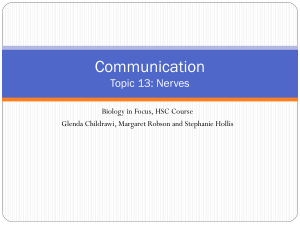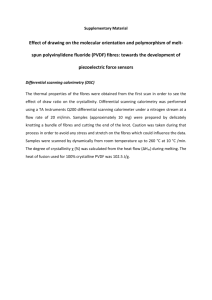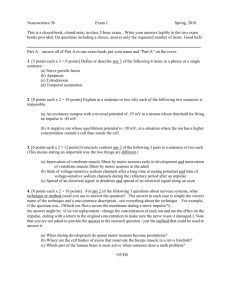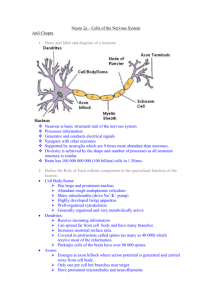Types of supporting tissue
advertisement
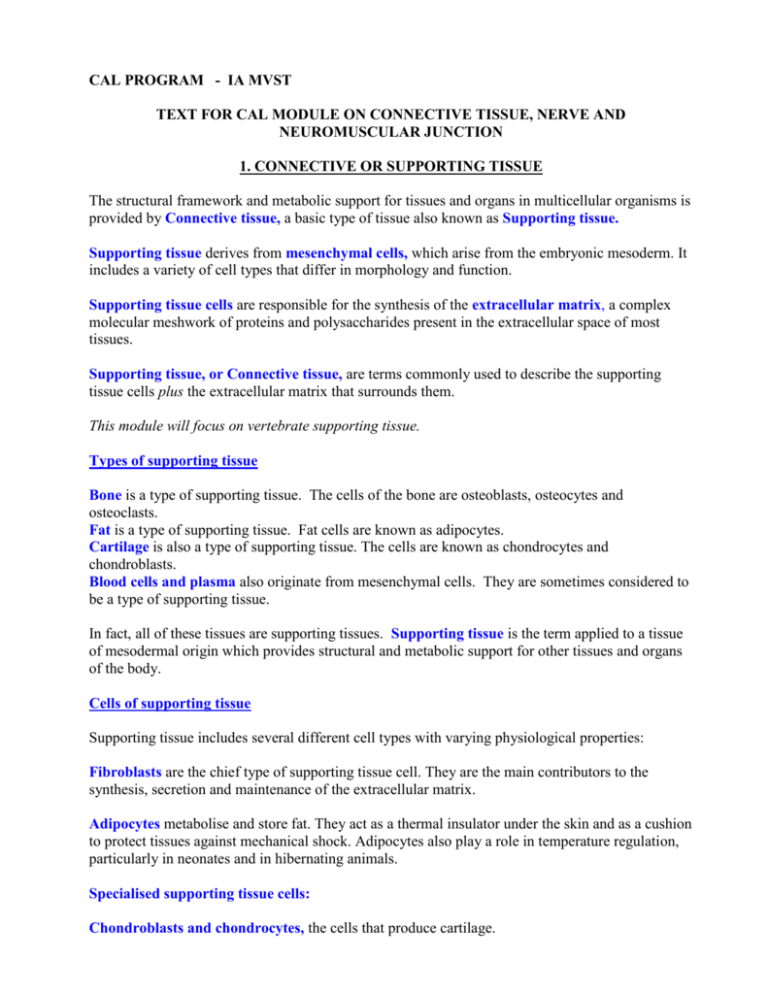
CAL PROGRAM - IA MVST TEXT FOR CAL MODULE ON CONNECTIVE TISSUE, NERVE AND NEUROMUSCULAR JUNCTION 1. CONNECTIVE OR SUPPORTING TISSUE The structural framework and metabolic support for tissues and organs in multicellular organisms is provided by Connective tissue, a basic type of tissue also known as Supporting tissue. Supporting tissue derives from mesenchymal cells, which arise from the embryonic mesoderm. It includes a variety of cell types that differ in morphology and function. Supporting tissue cells are responsible for the synthesis of the extracellular matrix, a complex molecular meshwork of proteins and polysaccharides present in the extracellular space of most tissues. Supporting tissue, or Connective tissue, are terms commonly used to describe the supporting tissue cells plus the extracellular matrix that surrounds them. This module will focus on vertebrate supporting tissue. Types of supporting tissue Bone is a type of supporting tissue. The cells of the bone are osteoblasts, osteocytes and osteoclasts. Fat is a type of supporting tissue. Fat cells are known as adipocytes. Cartilage is also a type of supporting tissue. The cells are known as chondrocytes and chondroblasts. Blood cells and plasma also originate from mesenchymal cells. They are sometimes considered to be a type of supporting tissue. In fact, all of these tissues are supporting tissues. Supporting tissue is the term applied to a tissue of mesodermal origin which provides structural and metabolic support for other tissues and organs of the body. Cells of supporting tissue Supporting tissue includes several different cell types with varying physiological properties: Fibroblasts are the chief type of supporting tissue cell. They are the main contributors to the synthesis, secretion and maintenance of the extracellular matrix. Adipocytes metabolise and store fat. They act as a thermal insulator under the skin and as a cushion to protect tissues against mechanical shock. Adipocytes also play a role in temperature regulation, particularly in neonates and in hibernating animals. Specialised supporting tissue cells: Chondroblasts and chondrocytes, the cells that produce cartilage. Osteoblasts and osteocytes, responsible for bone formation. Osteoclasts, which participate in bone resorption and remodeling. Myoblasts, the precursors of muscle cells, are also considered to be a type of supporting tissue cell. Other specialised cells with a role in defence and immunity: Tissue macrophages (histiocytes), thought to derive from monocytes. Mast cells, which release histamine when stimulated during an inflammatory or allergic response. All types of white blood cells. ----------------------------------------------------------------------------------------------------------------------Fibroblasts are the most abundant type of supporting tissue cell. They are distributed widely in the extracellular matrix. In the micrograph of the trachea, fibroblasts can be seen in the supporting tissue under the epithelium. Fibroblasts are elongated and thin. Their nucleus is also elongated, usually in the direction of the extracellular matrix fibres that surround them. In this tissue, the matrix fibres are made up of collagen which is stained pink. Fibroblasts synthesize and secrete the precursors of collagen, elastin, proteoglycans, and all other components of the extracellular matrix. Under EM fibroblasts show a fusiform shape, tapering towards both ends. (The next image shows more details of this cell). --------------------------------------------------------------------------------------------------------------------Adipose tissue includes white fat and brown fat. This LM shows white adipocytes which serve mainly as energy storage and protective cushion. They also act as a thermal insulator under the skin. White fat is stored as a single large droplet which occupies most of the cell leaving only a thin rim of cytoplasm and a peripheral nucleus. Most adipose tissue is white fat. This micrograph shows white adipocytes fixed with osmium, which preserves the lipid and stains it black. Brown fat is mainly found in newborn mammals and hibernating animals. Brown fat plays a role in thermoregulation. Brown adipocytes are smaller than white adipocytes, and store fat in multiple small droplets. --------------------------------------------------------------------------------------------------------------------EXTRACELLULAR MATRIX (ECM) The extracellular matrix (ECM) is an organized meshwork of protein and ploysaccharide molecules. It contains fibrous proteins that provide structural support and which are embedded in a hydrated polysaccharide gel known as the ground substance. In addition to filling up the spaces between cells, the extracellular matrix participates in the regulation of cell differentiation, growth, shape, proliferation and migration. The ECM molecules are synthesized and secreted by local cells in contact with the matrix, especially fibroblasts. The main proteins that constitute the extracelluar matrix are collagen, elastin and fibronectin._ Collagen refers to a family of fibrous proteins with a defined structure, arranged into coarse interwoven bundles. They are the most abundant proteins in mammals and can have a tensile strength equivalent to steel! Under EM, the typical appearance of type I collagen (the most widespread) is a pattern of cross banding with a periodicity of 67 nm. Bundles of collagen are found in loose connective tissue, dermis, bone, tendons, ligaments and organ capsules. This LM (trachea) shows loosely arranged collagenous tissue supporting the epithelial lining of the trachea. In this slide preparation, collagen fibres are stained red. Ground substance fills the spaces between collagen fibres (not evident here, as it is dissolved away during tissue processing). Dense collagenous tissue is found in the dermis layer of the skin, as in this LM. Collagen fibres, stained red in this preparation, are organised in wavy, irregular bundles that provide tensile strength. Fibroblasts, responsible for collagen production, are stained blue. -----------------------------------------------------------------------------------------------------------------------Tendons are composed of densely packed bundles of collagen fibres aligned in the same general direction. This confers enormous tensile strength. Tendons attach strongly to skeletal muscle and bone. This LM shows a myotendinous junction. -----------------------------------------------------------------------------------------------------------------------Elastic fibres consist mainly of an amorphus glycoprotein called elastin and numerous proteinaceous microfibrils that become embedded in the elastin. Elastic fibres are found in most connective tissues, as short branching fibres, conferring elasticity. Elastin is present in large amounts in tissues such as lung, skin and urinary bladder. This LM of the lung shows elastic fibres stained black. A large number of elastic (and collagenous) fibres are found within the alveolar walls, forming a 3D supporting meshwork. Elastic fibres, sometimes just called elastin, are found in the wall of blood vessels, such as in this LM of a large artery. The resulting elasticity enables recovery of shape after deformation. In this enlargement (artery), sheets of elastin, separated by smooth muscle fibres (blue) within the artery wall, can be seen more clearly. ---------------------------------------------------------------------------------------------------------------------Ground substance refers to a markedly hydrated gel-like substance that occupies all space between the supporting tissue cells and fibres. Under EM, ground substance appears as an amorphous mass, without the microfibrils seen in elastin. Ground substance consists mostly of a mixture of glycosaminoglycans, proteoglycans and glycoproteins of varying functions (refer to class book). The aqueous phase of the gel enables the diffusion of nutrients, metabolites, salts and hormones between the blood and tissue cells. -------------------------------------------------------------------------------------------------------------------Variations in supporting tissue cell types, extracellular matrix composition and in the density and organisation of their components, gives rise to a great diversity of forms, each designed for a specific function: Cartilage is a specialized, semi-rigid form of supporting tissue. Its cells, called chondrocytes, are scattered in the extracellular matrix occupying small cavities (lacunae). Hyaline cartilage is the most widespread. The matrix is made up of collagen and proteoglycans, as in this LM of the trachea. Fibrocartilage and elastic cartilage are considered variants of hyaline cartilage, based on their matrix composition. Bone is a specialized form of supporting tissue. It provides a rigid protective framework for most of the soft tissues of the body. Osteocytes are the principal cells within adult bone. They reside in lacunae within the calcified matrix and play an active role in the maintenance of the matrix. The ground substance contains a large amount of inorganic salts, predominantly hydroxyapatite (a complex calcium salt) crystals. The organic component is composed mainly of type I collagen and proteoglycans. 2. NERVOUS TISSUE THE NEURONE The nervous system consists of billions of cells, called neurones, and supporting or glial cells. Neurones are specialised to receive, process, integrate and conduct electrical signals to activate other cells. The signals are transmitted from cell to cell at synapses. The vast majority of synapses relay the electrical signals by means of a chemical neurotransmitter. The size and shape of neurones is highly variable. Neurones also differ in the neurotransmitter they release. This LM of a motor neurone shows the basic structural features of all neurones. Neurones have a large cell body or soma containing a pale-staining nucleus with a prominent nucleolus. Most neurone cell bodies are located in the central nervous system. Dendrites are a number of highly branched processes that extend from the cell body. They usually conduct incoming signals to the cell body. The axon is a single process that conducts signals from the cell body to distant targets. It is generally longer than the dendrites and it divides into many branches, called terminals, at its far end. Multipolar neurones have one axon and many dendrites. The axon arises from a conical extension of the cell body called the axon hillock. The cytoplasm of the cell body contains large clumps of rough ER, known as Nissl substance. This extends into the dendrites, but not to the axon hillock or axon. -----------------------------------------------------------------------------------------------------------------------Ganglia are discrete aggregations of neurone cell bodies located outside the central nervous system, associated with supporting glial cells. Ganglia participate in integrating and relaying information along motor or sensory nerve pathways. The cell bodies of primary sensory neurones and those of terminal effector neurones (second order neurones) of the autonomic nervous system (sympathetic and parasympathetic) reside in spinal or autonomic ganglia, respectively. (Please refer to your class handbook for more information on the functional anatomy of the nervous system) ----------------------------------------------------------------------------------------------------------------------. Micrograph of a sensory ganglion (swelling of the dorsal root of a spinal nerve): It contains the cell bodies of pseudo-unipolar primary sensory neurones surrounded by satellite cells, a type of glial cell, which provide structural and metabolic support. ----------------------------------------------------------------------------------------------------------------------Sympathetic ganglia contain multipolar neurones. Sympathetic ganglia have the same basic structure as sensory ganglia. However, in general there is more space between the neurones. This is due to the numerous axons and dendrites that pass through the ganglion. -----------------------------------------------------------------------------------------------------------------------The ganglia containing cell bodies of the parasympathetic system are found within the target organs as in this small parasympathetic ganglion in a salivary gland. The nerve cell bodies are large and stained pink. They are surrounded by support cells and by nerve fibres. THE NERVE TRUNK (Transverse section of a nerve) A nerve trunk is a bundle of nerve fibres (or axons), bound together and surrounded by a sheath of supporting tissue. Peripheral nerves may be composed of one or more bundles of varying size, bound together by a layer of loose supporting tissue called the epineurium. The cell bodies of peripheral nerve fibres are located either in the central nervous system or in peripheral ganglia. Nerve trunks are surrounded by a dense layer of supporting tissue called perineurium. From the perineurium, a fine network of supporting tissue containing numerous blood vessels, called the endoneurium, extends inwardly to surround each axon. Many peripheral axons are enveloped by a myelin sheath. This is formed by Schwann cells and consists of many concentric layers of plasma membrane. In preparations fixed with osmium, the lipid component of myelin is preserved and stained black. Rings of myelin can be seen in this LM (cross section of a nerve trunk, fixed with osmium), surrounding individual axons of various diameters. ---------------------------------------------------------------EM of a peripheral nerve (transverse section) from a newborn rat fixed with osmium. It contains axons of various sizes, some of which are surrounded by a tight myelin sheath. Myelin acts as an insulator and increases the conduction velocity relative to unmyelinated axons of comparable size. All axons in the peripheral nervous system are enveloped by Schwann cells, although small diameter axons are not myelinated. ----------------------------------------------------------------(LM of myelinated axons, longitudinal section): In myelinated axons, the myelin sheath is formed by many Schwann cells. Each Schwann cell covers a segment of axon of about 1 mm in length. Between adjacent segments, the axon membrane is not covered by myelin. These areas are called nodes of Ranvier. ----------------------------------------------------------------(EM of a myelinated axon, longitudinal section): This EM shows details of the node of Ranvier. You can see that the myelin sheath decreases in thickness as it approaches the node. Nodes of Ranvier are about 0.5 mm long and have a high density of Na channels. Action potentials are triggered here and the nervous impulse skips from node to node giving rise to saltatory conduction. THE NEUROMUSCULAR JUNCTION Neuromuscular junctions are the sites at which motor neurones synapse with skeletal muscle. Each neurone may synapse with few or hundreds of muscle fibres. The neurone and the muscle fibre(s) together constitute a motor unit. This LM shows the end of a nerve fibre dividing into several branches, each terminating as a motor end plate on a different muscle fibre. ---------------------------------------------------------------------------Scanning EM showing a 3-D view of a motor unit: At the motor end plate, the axons branches further divide to form a cluster of swellings called terminal boutons. This EM shows one of the terminal boutons of a motor end-plate, situated in a depression on the skeletal muscle cell surface. The terminal bouton contains mitochondria and numerous synaptic vesicles. The axon terminal is separated from the muscle fibre by the synaptic cleft (which appears in this EM as a dark line). The muscle membrane (sarcolemma) is indented to form synaptic folds. Acetylcholine is released from vesicles in the axon terminal into the cleft where, after diffusing across, they bind to specific receptors in the postsynaptic (muscle) membrane.
